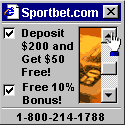| Baccarat Blackjack
Craps
Roulette
Slots
Video Poker
Three-card Poker
Pai Gow Poker
Texas Hold'em
Caribbean Stud
Let It Ride
Casino War
Big Six
Sic Bo
Trente et Quarante
Game Rules
Systems Gallery
Order Form
On-Line Forum
Post a Gambling
Question or Opinion -
Get an Answer. . .




|
Rules and Strategies for
Trente et Quarante
Trente-et-Quarante is a popular card game that is heavily played in
France but can also be found in other parts of Europe. The name
Trente-et-Quarante means thirty and forty. It is also called Rouge et
Noir (Red and Black).
How to Play Trente-et-Quarante
In this game, a croupier deals out two separate rows of cards (red and
black), sequentially. Players have the option of betting on either
colored row, red or black, to win. In Trente-et-Quarante, cards are
counted face value. All face cards are counted as 10, just as they are
in blackjack. After each row totals greater than 30, the hand is
settled.
Whichever row comes closest to 31 wins even money. During a tie at 31,
the house (casino) takes half of every bet. The house advantage in this
game is found in the tie situations.
In addition to betting on rows, players can also place bets on either
"color" or "inverse". The "color" wager is a type of bet that the first
card of the row that wins will be the same color as the winning row. The
"inverse" wager is the opposite of the "color" wager. It is a bet that
first card of the winning row will be the opposite color of the winning
row.
Similar to blackjack, there is also an insurance wager that can be made.
This wager can be made at 1% of the total bet and it cancels the
half-loss during the event of a tie at 31. Insurance in this game is
recommended.
Trente-et-Quarante House Advantage
In Trente-et-Quarante, the house advantage is very mere at around 1% on
all wagers. This is one of the lowest house edges that can be seen in
most casino table games. There is no difference in the casino advantage
on the different types of bets offered in this game. By taking insurance
you can slightly reduce the overall house edge so insurance is generally
recommended.
The strategy of card counting can be used to a certain extent in this
game but it usually isn't very effective in swaying the house edge.
There is no counting system that can overcome the house advantage for
red and black bets. These bets are almost completely symmetrical which
hurts card counting.
Professor Edward O. Thorp examined the possibility of beating color and
inverse bets but through detailed computer analysis he proved that even
with a computer these bets couldn't be beaten in any practical way.
You can use Izak Matatya's even bet strategies,
however, to overcome the house edge and come out a winner, particularly
with the great IBS3 system and using differential
betting (DB) on both sides incorporated with the IBS3 system.
How Trente et Quarante is Played at Monte Carlo
and at the French Riviera
Trente et Quarante is one of the two games played in the gambling rooms
at Monte Carlo, roulette being the other.
Two croupiers sit on each side of the table, one of them being the
dealer; behind the two on the side opposite to the dealer a supervisor
of the game has his seat. Six packs of fifty-two cards each are used;
these are well shuffled, and the croupier asks any of the players to
cut, handing him a blank card with which to divide the mixed packs.
There are only four chances at trente et quarante: rouge or noir, known
as the grand tableau', couleur or inverse, known as the petit tableau.
At Monte Carlo the stakes are placed on the divisions indicated on the
table, the maximum being 12,000 francs and the minimum 20 francs which
must be staked in gold. The dealer, who has placed all the cards before
him, separates a few with the blank card, takes them in his left hand
and invites the players to stake with the formula, "Messieurs, faites
vos jeux!" After a pause he exclaims "Le jeu est fait, rien ne va plus!"
after which no stake can be made. He then deals the cards in a row until
the aggregate number of pips is something more than thirty, upon which
he deals a second row, and that which comes nearest to thirty wins, the
top row being always distinguished as noir, and the lower as rouge. In
announcing the result the word "trente" is always omitted, the dealer
merely announcing "un, trois, quatre", as the case may be, though when
forty is turned up it is described as quarante. The words noir and
inverse are also never used, the announcement being rouge gagne or rouge
perd, couleur gagne or couleur perd. Gain or loss over couleur and
inverse depends upon the color of the first card dealt.
If this should be also the color of the winning row, the player wins.
Assuming, for example, that the first card dealt is red, and that the
lower row of the cards dealt is nearest to thirty, the dealer will
announce "Rouge gagne et le couleur." If the first card dealt is red,
but the black or top row of cards is nearest to thirty, the dealer
announces "Rouge perd et le couleur."
It frequently happens that both rows of cards when added together give
the same number. Should they both, for instance, add up to thirty-three,
the dealer will announce "Trois apres," and the deal goes for nothing
except in the event of their adding up to thirty-one.
Un apres (i.e. thirty-one) is known as a refait; the stakes are put in
prison to be left for the decision of the next deal, or if the player
prefers it he can withdraw half his stake, leaving the other half for
the bank. Assurance against a refait can be made by paying 1% on the
value of the stake with a minimum of five francs. When thus insured
against a refait the player is at liberty to withdraw his whole stake.
It has been calculated that on an average a refait occurs once in
thirty-eight coups.
After each deal the cards are pushed into a metal bowl let into the
table in front of the dealer. When he has not en'ough left to complete
the two rows, he remarks "Les cartes passent"; they are taken from the
bowl, reshuffled, and another deal begins.
If you are ever in a European casino and come across Trente-et-Quarante,
it is an excellent and enjoyable table game that offers very good value
for the slight edge that it carries.
Poker Guide -
The world's largest poker
guide PokerListings.com with reviews of 750 poker sites.
|
|
|
|
Texas Holdem -
Page that compares 45
Texas Holdem online poker rooms on a number of relevant features.
|
|
|
|